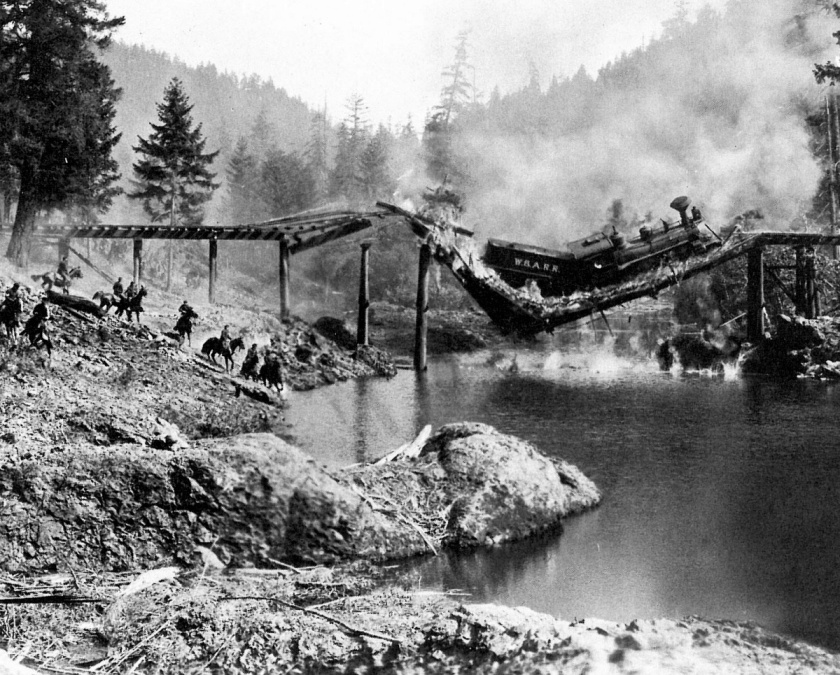Hanspostcard is hosting a movie draft from 12 different genres…this is my Silent Movie entry.
Buster Keaton was a little off kilter to his comedy peers. He was more subtle than Chaplin or Harold Lloyd. Keaton used non movement to his advantage. You would see him in a crowd easily. They would be moving along and his stillness would get your attention.
Chaplin had two rivals in comedy at the time. Buster Keaton and Harold Lloyd. Lloyd was more successful than Keaton but he was more of an actor playing a comedian on screen. Charlie and Buster were stage trained natural comedians and made some of the best comedies of the teens and twenties…and some would say all time.
Buster was an excellent filmmaker. I would put him over Chaplin in that regard. Buster didn’t fake stunts…he didn’t like cutting in at the last minute. He wanted the gag or whatever it was to be filmed in one shot and completely natural.
This is Buster Keaton’s civil war era masterpiece. It was released in 1927 to mediocre reviews. Keaton was ahead of his time and it caught the audience by surprise. This movie is now considered one of the best movies ever made. Buster wanted to make it look real to the era. He told his crew to make it so authentic that it hurt. This film is a reference point to some people to see what the Civil War looked like.
This film contained the most expensive shot in silent movie history. Buster had free rein on this movie and it showed. His budget was $750,000 dollars which was huge at the time for a comedy. Buster had a bridge built just to have a train go across it and crash. The single scene cost 42,000 in 1927 dollars. In today’s money that would be over half a million. But doesn’t it look great?

Buster made the movie in Cottage Grove Oregon. Animal House would be made there 51 years later. When World War 2 came, the train was pulled out of the creek bed and used for scrap iron. People say you can still find fragments around this site of the train.
This movie was based on a true story in the civil war known now as The Great Locomotive Chase or Andrew’s Raid.
The Great Locomotive Chase unfolded during the early years of the Civil War, an attempt by Union forces and sympathizers to destroy railroad infrastructure north of Atlanta, Georgia in hopes of eventually capturing the strategic city of Chattanooga, Tennessee. The celebrity locomotive in what also became known as Andrews’ Raid was the Western & Atlantic Railroad’s General. The American Type 4-4-0 steamer was commandeered by James Andrews himself (leader of the raid) and used throughout the chase where he traveled northward from Atlanta causing as much damage as he could. Unfortunately, the hasty Union plans were too slow and disorganized to cause serious damage and most of those involved were eventually captured.
Buster made very few changes in the story. He kept his eye on details though. The cannon he used in the film was built to the specs of the Civil War Era.
When he shot the cannonball from the cannon railway car on the train to land in the locomotive… he kept trying different measures of powder to get it right until he had to use tweezers to get the right amount. He would do gags without camera trickery when he could. Below is the cannon shot… shot without cuts.

He worked for an independent producer Joseph Schenck so he had complete control of his movies. A little while after this movie lost money he had to go into the studio system and still managed to make a couple of great movies for MGM but after that, the studio would control everything he did which meant the quality of his movies took a nose dive.
Keaton was an incredible filmmaker. This movie is a true chase movie. Buster is either chasing the General (train) after it was stolen or being chased by the Union Army in the “Texas” until it crashes in the ravine.
If you have never seen a silent movie…this is a good one to start at…this one and The Gold Rush by Chaplin.
This is one I hope I will be able to see on the big screen one day.
It ranks #155 on the best movies ever on IMDB.
Cast
- Buster Keaton – Johnnie Gray, Director, Editor, Screenwriter
- Marion Mack – Annabelle Lee
- Glen Cavender – Capt. Anderson
- Jim Farley – Gen, Thatcher
- Fred Vroom – Southern General
- Richard Allen – His Son
- Joe Keaton – Union General
- Mike Donlin – Union General
- Tom Nawn – Union General
- Charles H. Smith – Mr. Lee, Screenwriter
- Ray Thomas – Raider
- Jimmy Bryant – Raider
- Ross McCutcheon – Raider
- Charles Phillips – Raider
- Anthony Harvey Raider
- Edward Hearn – Union Officer
- Budd Fine-Raider
- Frank S. Hagney – Recruiting Officer



Heh. All your comments are over at Hans place. So, I show up and graffiti up the place…
LikeLiked by 2 people
I’m a bit taken aback that Buster and the crew left the wrecked train lying in the creek after filming the scene, and it remained there nearly 15 years until the start of WWII. That would never be allowed today.
LikeLiked by 2 people
No it wouldn’t be allowed today. I wonder at that time if they had the equipment to get it out? I’m sure they had cranes somewhere there… I would love to go to that spot just to see if I could find a piece.
LikeLiked by 2 people
I just picked this up from the library today. Can’t wait to watch it 🙂
LikeLiked by 1 person
I think you will like it. The detail he put into it is great!
LikeLiked by 1 person
p.s. it’s a 2-disc set so there must be a lot of special features to watch as well.
LikeLiked by 1 person
That is cool…it was his masterpiece no doubt although critics at the time didn’t think so…it was ahead of it’s time.
LikeLiked by 1 person
I recall seeing “The General” on the Nostalgia Channel in the 1990s. They scored it with Jon Lord’s “Gemini Suite”, “Statosfear” by Tangerine Dream and “Piano Concerto No. 1” by Emerson, Lake and Palmer. It was weird, but it worked for me.
LikeLiked by 1 person
I have to admit…that sounds really cool
LikeLike